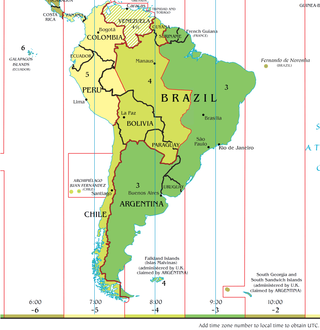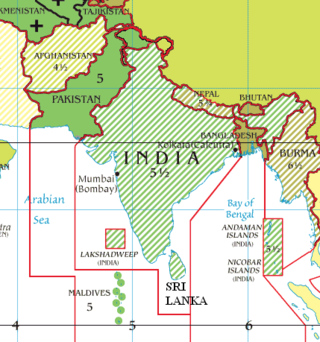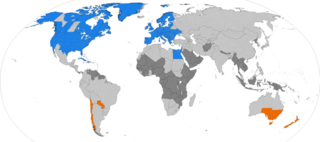Related Research Articles

The Eastern Time Zone (ET) is a time zone encompassing part or all of 23 states in the eastern part of the United States, parts of eastern Canada, and the state of Quintana Roo in Mexico.

The Mountain Time Zone of North America keeps time by subtracting seven hours from Coordinated Universal Time (UTC) when standard time (UTC−07:00) is in effect, and by subtracting six hours during daylight saving time (UTC−06:00). The clock time in this zone is based on the mean solar time at the 105th meridian west of the Greenwich Observatory. In the United States, the exact specification for the location of time zones and the dividing lines between zones is set forth in the Code of Federal Regulations at 49 CFR 71.

Summer time in Europe is the variation of standard clock time that is applied in most European countries in the period between spring and autumn, during which clocks are advanced by one hour from the time observed in the rest of the year, with a view to making the most efficient use of seasonal daylight. It corresponds to the notion and practice of daylight saving time (DST) to be found in some other parts of the world.

Moscow Time is the time zone for the city of Moscow, Russia, and most of western Russia, including Saint Petersburg. It is the second-westernmost of the eleven time zones of Russia. It has been set to UTC+03:00 without DST since 26 October 2014; before that date it had been set to UTC+04:00 year-round on 27 March 2011.

Australia uses three main time zones: Australian Eastern Standard Time, Australian Central Standard Time and Australian Western Standard Time.

Time in Brazil is calculated using standard time, and the country is divided into four standard time zones: UTC−02:00, UTC−03:00, UTC−04:00 and UTC−05:00.
Time in Chile is divided into three time zones. Most of Continental Chile uses the time offset UTC−04:00 in winter time and UTC−03:00 in summer time, while the Magallanes and Chilean Antarctica region uses the time offset UTC−03:00 the whole year. Additionally, Easter Island uses the time offset UTC−06:00 in winter time and UTC−05:00 in summer time.

Argentina is located at a longitude that would naturally put it in the UTC−04:00 or UTC−05:00 time zone; however, it actually uses the UTC−03:00 time zone. Argentina determines whether to change clocks in observation of daylight saving time on a year-by-year basis, and individual provinces may opt out of the federal decision. At present, Argentina does not change clocks.

Egypt Standard Time (EGY) is UTC+02:00, which is equivalent to Eastern European Time, Central Africa Time, South African Standard Time and Central European Summer Time, and is co-linear with neighbouring Libya and Sudan. Egypt has used Eastern European Summer Time (UTC+03:00), during the summer periods from 1957 to 2010, 2014, 2015, and 2023.

Iran Standard Time (IRST) or Iran Time (IT) is the time zone used in Iran. Iran uses a UTC offset UTC+03:30. IRST is defined by the 52.5 degrees east meridian, the same meridian which defines the Iranian calendar and is the official meridian of Iran.

Bangladesh Standard Time is the time zone of Bangladesh. It is offset six hours ahead of Coordinated Universal Time, and observed as a national standard throughout the country. Bangladesh briefly observed daylight saving time (DST) in 2009 to cope with the ongoing electricity crisis, but in 2010 the decision was cancelled by the government of Bangladesh.

Most of the United States observes daylight saving time, the practice of setting the clock forward by one hour when there is longer daylight during the day, so that evenings have more daylight and mornings have less. Exceptions include Arizona, Hawaii, and the territories of American Samoa, Guam, the Northern Mariana Islands, Puerto Rico, and the United States Virgin Islands. The Uniform Time Act of 1966 established the system of uniform daylight saving time throughout the US.
Samoa uses UTC+13:00 as standard time. Until the end of 2011, it used UTC−11:00 as standard time. Samoa observed daylight saving time from 2010 to 2021.
Brazil observed daylight saving time (DST) in the years of 1931–1933, 1949–1953, 1963–1968 and 1985–2019. Initially it applied to the whole country, but from 1988 it applied only to part of the country, usually the southern regions, where DST is more useful due to a larger seasonal variation in daylight duration.
Paraguay observes UTC−04:00 for standard time (PYT), and UTC−03:00 for daylight saving time/summer time (PYST).
Daylight saving time in the Americas is the arrangement in the Americas by which clocks are advanced by one hour in spring and moved back in autumn, to make the most of seasonal daylight. The practice is widespread in North America, with most of Canada and the United States participating, but much less so in Central and South America.

As of 2022, daylight saving time is used in the following Asian countries:

African countries, apart from Egypt, do not use daylight saving time (DST) although some did in the past. Only the territories of the Canary Islands, Ceuta and Melilla (Spain) and Madeira (Portugal) implement DST from the last Sunday in March to the last Sunday in October. Although these regions politically belong to Europe, they are geographically part of Africa. They have DST schedules according to European Union rules.

Daylight saving time (DST), also known as summer time, is the practice of advancing clocks during part of the year, typically by one hour around spring and summer, so that daylight ends at a later time of the day. As of 2024, DST is observed in most of Europe, most of North America and parts of Africa and Asia around the Northern Hemisphere summer, and in parts of South America and Oceania around the Southern Hemisphere summer. It was also formerly observed in other areas.
Uruguay is located at a longitude appropriate for a UTC−04:00 time zone offset, but it actually uses a UTC−03:00 offset. Uruguay used to observe daylight saving time (UTC−02:00) from October until March. On 30 June 2015, the Uruguayan government decided to abolish DST, establishing the UTC−03:00 time zone all year round. The term "UYT" is used in and out of the country to convey specific Uruguay time.
